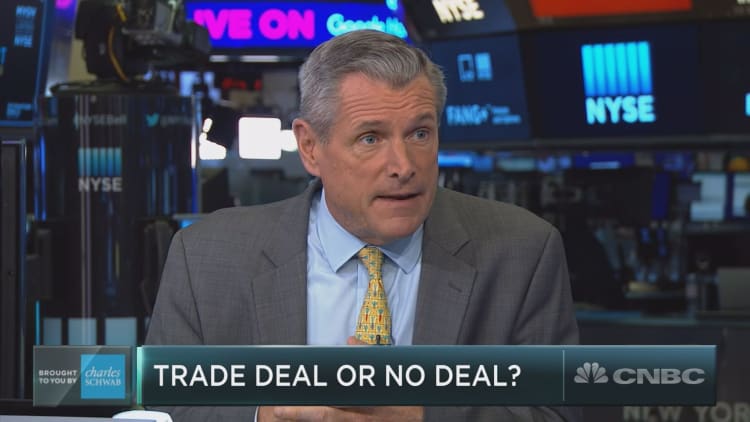
Deal or no deal?
That's the question many investors are asking themselves after a hiccup in U.S.-China trade talks this week, with the Trump administration threatening to raise tariffs on Chinese goods by Friday barring any meaningful progress made during the Chinese vice premier's visit to the U.S.
As it relates to the stock market, the absence of a trade deal in the first half of 2019 could mean trouble, warned Art Hogan, chief market strategist at investment banking firm National Securities.
"If, in fact, we drag this process out for a period of time instead of getting a deal done in the first half of this year, ... that's going to be a drag on GDP, and that drag on GDP is going to manifest itself in lower earnings, so we'd have to take our targets down," Hogan said Wednesday on CNBC's "Trading Nation."
Hogan's current S&P 500 target for the end of this year is 2,900, but that could be slashed to as low as 2,700 if a deal doesn't go through, he said, explaining that while he'd keep his market multiple the same, he'd be forced to "take a pretty good whack" at his assumptions for the end of 2019.
"That would be kind of a fair value" for the S&P, the strategist said. "That's not saying we're going to do that, but that's exactly the kind of methodology we'd think about, and that's a 6% cut."
If a U.S.-China trade deal is completed — especially if it's a good one — and U.S. trade authorities don't put tariffs on European autos, as some fear they might, Hogan said he might take that 2,900 target even higher.
"If both those things happen and we can sort of skate through this trade war concern, I certainly think that there's upside to that target. I think the earnings estimates that we have for the back end of this year probably go higher," Hogan said.
"We [would] have a lot of economic energy that explodes into the global economy, manifests itself in better economic data and better earnings, certainly into the front half of 2020," he said. "But I think the risk is to the upside if we get this right on trade, but the risk to the downside [is] not symmetric. I think it's asymmetric risk to the downside if we get this wrong."
He warned that if the U.S. and China are unable to come to an agreement, then the second half of the year — where Hogan assumes "the growth is going to be" — will end up being difficult for stocks and investors.
"If that [growth is] going to dissipate at all, then where we are right now looks expensive," he said.
Hogan said investors might want to look to the energy and financial sectors for value during upcoming marketwide pullbacks, and that they should steer clear of utilities, consumer staples and semiconductors, the latter of which he called the "tip of the sword" in the U.S.-China trade dispute.
The major averages fell Thursday morning, a day after President Donald Trump said at a rally that China "broke the deal" in trade talks.






